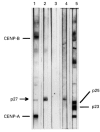cDNA cloning of a novel autoantigen targeted by a minor subset of anti-centromere antibodies
- PMID: 9486406
- PMCID: PMC1904897
- DOI: 10.1046/j.1365-2249.1998.00517.x
cDNA cloning of a novel autoantigen targeted by a minor subset of anti-centromere antibodies
Abstract
Using autoimmune serum from a patient with anti-centromere antibodies, we have identified and partially characterized a novel protein with a mol. wt of approximately 27 kD (hereafter referred to as p27). A cDNA expression library was screened with this serum, and two overlapping inserts were isolated among three positive clones other than clones corresponding to centromere protein (CENP)-B and CENP-C. Analysis of the sequence showed an open reading frame of approximately 0.6 kb encoding 199 amino acids with a predicted mol. wt of 21.5 kD. Immunoblotting analysis with bacterial recombinant p27 showed that approximately 2% of anti-centromere antibody-positive patients had autoantibodies to p27, whereas only one of 215 autoimmune patients without anti-centromere antibodies reacted with the recombinant. All five cases with anti-p27 antibodies, who were diagnosed as having scleroderma and/or Sjögren's syndrome, showed internal organ involvement. Although affinity-purified anti-p27 human or mouse polyclonal antibodies failed to stain any cellular structures in an immunofluorescence study, the potential association of anti-p27 with anti-centromere antibodies suggests that this novel autoantigen might play a role in mitosis.
Figures



References
-
- Tan EM. Antinuclear antibodies: diagnostic markers for autoimmune diseases and probes for cell biology. Adv Immunol. 1989;44:93–151. - PubMed
-
- Muro Y, Sugimoto K, Okazaki T, Ohashi M. The heterogeneity of anticentromere antibodies in immunoblotting analysis. J Rheumatol. 1990;17:1042–7. - PubMed
-
- Saunders WS, Chue C, Goebl M, et al. Molecular cloning of a human homologue of Drosophila heterochromatin protein HP1 using anti-centromere autoantibodies with anti-chromo specificity. J Cell Sci. 1993;104:573–82. - PubMed
Publication types
MeSH terms
Substances
Associated data
- Actions
LinkOut - more resources
Full Text Sources
Molecular Biology Databases

